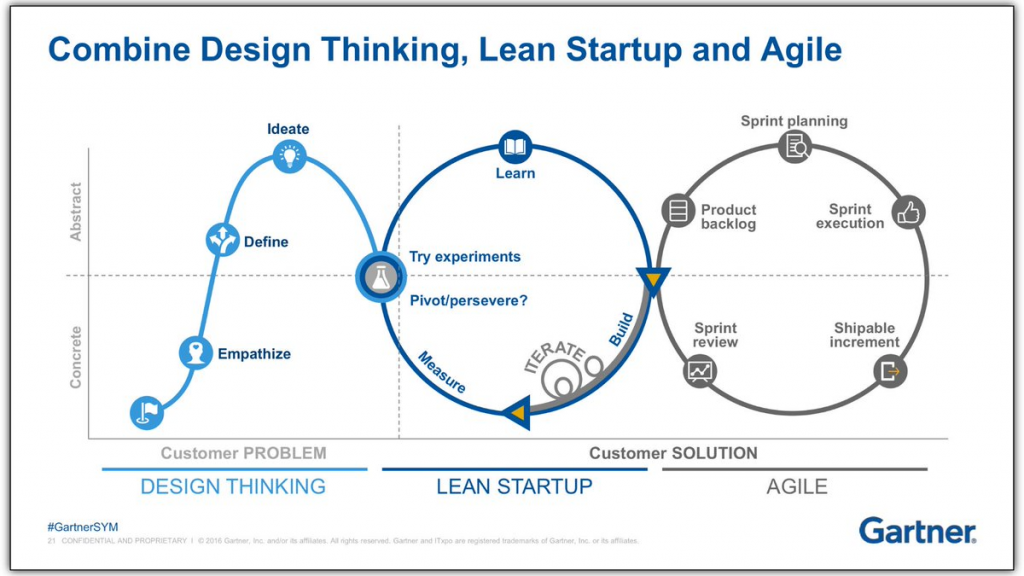Design Thinking, Lean Start-up, Agile: from theory to practice.
Design Thinking, Lean Start-Up, and Agile are methodologies to foster business opportunities, stimulate innovation, and speed time-to-market. They share many aspects in common, so much so that we sometimes tend to confuse them, when in fact they are complementary approaches within a company. Here is how and why it pays to apply them in a coordinated, cross-cutting way.
Design Thinking: creative thinking and dialogic exchange
Design Thinking is a methodology codified in the early 2000s by Tim Brown, CEO of California-based Ideo, who thus described it as “Design thinking is a human-centered approach to innovation that draws from the designer’s toolkit to integrate the needs of people, the possibilities of technology, and the requirements for business success.”
Design Thinking is based on the principles of strategic design and thus aims to find an innovative solution to a problem by taking into account three aspects: the human aspect (the “liking” of users), the economic aspect (the “sustainability” and “profitability”) and the technological aspect (the “feasibility”).
Design Thinking identifies 4 iterative stages: “empathizing” (knowing the real needs of users); “defining” (constructing a new point of view based on the identified needs); “ideating” (devising new strategies and solutions); and “prototyping” (testing the solutions, initially sketched out in a rudimentary way).
Another distinguishing feature of this methodology is the involvement of a multidisciplinary team to approach an issue from different perspectives.
Many companies see Design Thinking as a kind of “brainstorming” exceptional or occasional to conceive brilliant ideas, and the risk is a disengagement when the “killer idea” does not come; in fact it should be seen more as a practice of learning, updating and continuous generation through dialogue between different business functions.
Lean Start-Up: from idea to product
Lean Start-Up is a methodology for developing an idea and turning it into a business, aimed primarily at product managers. The originator of Lean Start-up is Eric Ries, who in his famous 2011 book “Lean Startup” defined it as follows: “The Lean Startup provides a scientific approach to creating and managing startups and get a desired product to customers’ hands faster. The Lean Startup method teaches you how to drive a startup-how to steer, when to turn, and when to persevere-and grow a business with maximum acceleration. It is a principled approach to new product development.”
Thus, this methodology aims to quickly test an idea’s potential in the market and shorten its development cycles by reducing waste. To this end, Lean Start-Up involves proceeding by cyclical, successive experiments of initial product versions (the Minimum Viable Products), moving to the next release only when customer feedback has been analyzed.
According to Forbes, globally 90 percent of start-ups fail and the number one reason for this failure is “They produce products no one wants” (Fortune) . This simple statistic explains very well why every company should use Lean Start-up to launch new products.
Agile: rapid and incremental development
Agile is a working method devised in 2001 by 17 developers who produced a manifesto for building software applications in a lighter, cheaper and faster way. According to the 12 principles of the Agile Manifesto, “Working software is the primary measure of progress. Deliver a rough draft, then revise based on your editor’s suggestions. Never deliver the entire piece all at once!”
Thus, the basic principles of the Agile method are iterative development, incremental release, and the possibility of changes even while the work is in progress. A strong emphasis is placed on comparison(interactions over documentation). In fact, Agile involves close collaboration between product managers and developers for continuous testing of subsequent releases and definition of incremental requirements and close interaction with the customer to develop valuable products.
The very nature of the Agile approach does not define the end result a priori, and therefore, in the same context, the results of different initiatives could overlap or interfere with each other. For this, various methodologies (LeSS, DAD, SAFe) have emerged to synchronize alignments, foster collaboration and releases among multiple Agile teams.
Design Thinking, Lean Start-up, Agile: how to integrate them and why
All three methodologies have in common the centrality of the client, and their advantages, at least theoretically, are clear.
In practice, however, their application is not easy, and experience and careful governance are needed to avoid slipping into dangerous “distortions.” Some common mistakes can discourage businesses and cause them to abandon these methodologies before they see the fruits ripen.
Design Thinking, for example, must know how to be guided and managed so that the ideas produced are actually feasible and consistent with business strategy.
The manager who adopts the Lean Start-Up approach must really be ready and feel “empowered” to “change his or her mind” based on feedback received, and not just define a priori what to release in the first release and subsequent releases.
As Agile moves toward being more responsive to customer demands, it must not turn into a condescending attitude, losing sight of the real utility of the end product.
Gartner shows how ideally, within a company the three approaches should combine sequentially:
– Empathizing, defining and ideating an idea through Design Thinking
– Turning the idea into a business model through Lean Start-up
– Build the final product and progressively improve it through Agile

In practice, there needs to be careful governance in applying these methodologies holistically within an enterprise, through true collaboration between marketing departments, designers, product managers, business developers, and product developers.
InfiniteArea teaches companies how to concretely apply these approaches within their own contexts, through interactive and experiential trainings and coaching interventions for managers and entrepreneurs.






